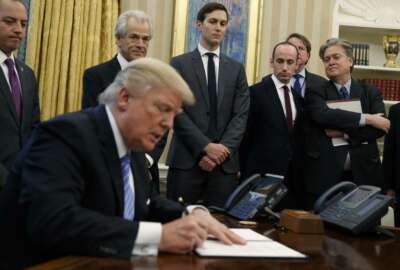

Does anyone need reminding of the thoroughly international content of PCs, smartphones, network switching equipment? And pencils?
Now that the Trump administration has ordered agencies to renew their buy-American practices and policies, my response is, fine, just go into it with your eyes open.
“Buy-American” might have a nice ring, and sure enough Congress has passed a series of laws going back more than a century to make sure federal buying power mainly helps American companies and employees. Buy-American is long enshrined in procurement law and regulation. As it should be.
The amount of goods for which Buy-American would apply is shrinking as a percentage of federal expenditures. Just the other day, the Government Accountability Office did a survey of indefinite delivery, indefinite quantity (IDIQ) vehicles. Two-thirds of what agencies spend in these popular deals go for services, not goods. That’s true for the Defense Department no less than for civilian agencies.
Still, the government does buy a lot of what you can see and touch. Cars and trucks, computers, Tomahawk missiles, uniforms of every description, airline tickets — a couple of hundred billion dollars a year, anyhow.
You can back out items like those Tomahawk missiles. They’re made by Raytheon in the U.S. There’s a service component to them — they have a finite lifespan before they require decommissioning. Because of what it knows exclusively about building them, Raytheon also gets the work to take them apart when the time comes. Who knows, maybe the 59 Tomahawks the U.S. fired at Syria were on the stale side, so what the heck. Yet, even guided missiles and the latest fighters have some international content. Back in 2014, Reuters reported the F-35 Join Strike Fighter had a few Chinese magnets here and there. Congress was alerted to the possibility of some non-U.S. sourced alloys used by subcontractors.
But what does it mean to “buy American” when it comes to, say, cars and computers? Cars might be assembled here, but the parts come from all over. My wife has a Subaru, from Fuji Heavy Industries. It was assembled in Lafayette, Indiana. My neighbor’s kid is the proud owner of a Jeep Renegade. What could be more hot-dog-and-Bud-long-neck than that? It’s assembled in Melfi, Italy.
Does anyone need reminding of the thoroughly international content of PCs, smartphones, network switching equipment? The first hit on a search, “Where are iPhones made?” turns up this Quora listing. The answer: On three continents.
My favorite writing instrument is the Dixon Ticonderoga #2 pencil, or equivalent as they say in solicitations. To aficionados, not all #2 pencils are equal. Many an essay has covered the pencil as a perfect example of the complexity of manufacturing and how things come to exist. A pencil represents the combination of wood, metal ferrule, yellow paint, graphite lead and rubber eraser — each of which is itself the result of a worldwide supply chain of mining, harvesting and processing. Alas, the Dixon Ticonderoga, product of a company founded in 1795, is made everywhere but in the United State. In fact, the company itself is a subsidiary of an Italian company called F.I.L.A. Group.
By all means the government should pursue buy American. I support the policy. But the government must pursue it with a dose of realism because manufacturing is a totally international function. If the executive order, which the president was to sign Tuesday, goes deep into product content, “Buy-American” won’t be possible.
Copyright © 2025 Federal News Network. All rights reserved. This website is not intended for users located within the European Economic Area.
Tom Temin is host of the Federal Drive and has been providing insight on federal technology and management issues for more than 30 years.
Follow @tteminWFED

 Exclusive
Exclusive 
